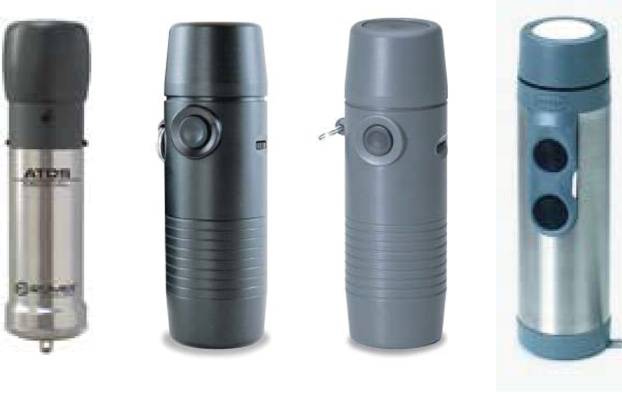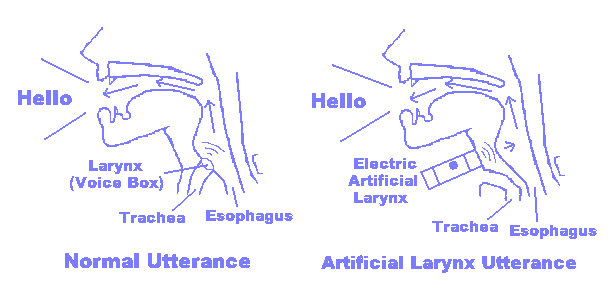Difference between revisions of "Electrolarynx"
(a correction) |
(a correction) |
||
| Line 17: | Line 17: | ||
== Historical overview == | == Historical overview == | ||
| − | + | The current electrolarynges are hand-held electromechanical devices that use a small vibrator to vibrate the inside of the oral cavity. But before miniaturization allowed such devices to be battery-powered and of portable size, pneumatic external larynxes were used. The first laryngeal prostheses was described by Czech physiologist Jan Nepomuk Czermak in 1859. This device was not electrical, however, but it was powered by the air. The voice was conducted through vibrating tube in patient's mouth. Based on the ideas of Czermak, Brucke actually invented a speech prostheses, which allowed patients to pronounced single syllables. First artificial larynx was invented by Billroth in 1873. The devices which could be extensively used by patients were developed in the beginning of 20th century by Glück. Although majority of his devices was powered by air, he also tested electrical devices. In the beginning of 20th century´, electrolarynges were still quite unreliable and the quality of sound was not sufficient. These features discouraged many possible patients from purchasing any of these devices. The disadvantages were overcame in 1924 by J. E. Mackenty, who found out than the soft rubber mouth piece,could improve the quality of patient's speech. In order to allow shipping of his invention, he cooperate with the Western Electric Company.<ref name="history">LASS, Norman, J, ed. Speech and Language: Advances in Basic research and Practice. New York: Academic Press, 1983. Available online at: https://books.google.cz/books?id=0C60BQAAQBAJ&pg=PA126&lpg=PA126&dq=Cooper-Rand+electrolarynx&source=bl&ots=or27eudDf2&sig=22heagC08Fpk57qGILvufHxwCyM&hl=cs&sa=X&ved=0ahUKEwi1--bt3r7RAhWGuxQKHbrFCC04ChDoAQgdMAE#v=onepage&q=Cooper-Rand%20electrolarynx&f=false (Retrieved 13th January, 2017).</ref> Therefore, the first available pneumatic artificial larynx was introduced by the Western Electric Company as the Western Electric No° 2 type larynx.<ref>Riesz R. Description and demonstration of an artificial larynx. Journal of the Acoustical Society of America 1929; 1: 273-9.</ref> It was available on the market from 1930 to 1959.<ref name="vandertorn">VAN DER TORN, Marein. A sound-producing voice prosthesis. Ph. D. Thesis. Amsterdam. VU Medical Center: VU Medical Center, 2005.</ref> These devices were attached to the tracheostoma of the patient. The device was shaped in such a way that the exhaled air produced a humming noise. It was then carried via a small tube to the inside of the patient's mouth where it served as a base for speech much like the vibrations produced by a modern electrolarynx.<ref>http://www.cancer.gov/publications/dictionaries/cancer-terms?CdrID=46223</ref> | |
TODO: Add picture of pneumatic larynx | TODO: Add picture of pneumatic larynx | ||
Revision as of 10:54, 13 January 2017
List of Electrolarynges:
Electrolarynges are Speech Technologies battery-powered devices that replace the sound-vibrating capabilities of the larynx and they usually resemble a small hand-held tube that the user operates with one hand. The device is put against the tissue of the throat or under the chin[1] and the user engages the vibrator on the device. The vibrations the device generates are then carried over to the inside of the oral cavity. The user can then use the rest of the vocal tract to shape the sound and speak.[2]
This allows people who have lost either a part or the entire larynx due to cancer to be able to produce speech and to communicate again.
http://drtbalu.com/Voice_rehab.html
Contents
Historical overview
The current electrolarynges are hand-held electromechanical devices that use a small vibrator to vibrate the inside of the oral cavity. But before miniaturization allowed such devices to be battery-powered and of portable size, pneumatic external larynxes were used. The first laryngeal prostheses was described by Czech physiologist Jan Nepomuk Czermak in 1859. This device was not electrical, however, but it was powered by the air. The voice was conducted through vibrating tube in patient's mouth. Based on the ideas of Czermak, Brucke actually invented a speech prostheses, which allowed patients to pronounced single syllables. First artificial larynx was invented by Billroth in 1873. The devices which could be extensively used by patients were developed in the beginning of 20th century by Glück. Although majority of his devices was powered by air, he also tested electrical devices. In the beginning of 20th century´, electrolarynges were still quite unreliable and the quality of sound was not sufficient. These features discouraged many possible patients from purchasing any of these devices. The disadvantages were overcame in 1924 by J. E. Mackenty, who found out than the soft rubber mouth piece,could improve the quality of patient's speech. In order to allow shipping of his invention, he cooperate with the Western Electric Company.[3] Therefore, the first available pneumatic artificial larynx was introduced by the Western Electric Company as the Western Electric No° 2 type larynx.[4] It was available on the market from 1930 to 1959.[5] These devices were attached to the tracheostoma of the patient. The device was shaped in such a way that the exhaled air produced a humming noise. It was then carried via a small tube to the inside of the patient's mouth where it served as a base for speech much like the vibrations produced by a modern electrolarynx.[6]
TODO: Add picture of pneumatic larynx
The first battery-powered electrolarynx was introduced by Wright in 1942. He joined Aurex Corporation and later Ketr Engineering Corporation, which developed first electrolarynges Aurex Model M 410 resp. Kett Mark I. These devices contained a vibrator connected by the battery with a cord. The later model of both companies Aurex Model M 520 and Kett Mark II, however, had battery included in a devices.[3] The example of the former type of device could be Cooper-Rand electrolarynx, while the latter type represents Nu-Vois, Romet R, Servox, SolaTone, and TruTone.
http://www.drshute.com/archives/2004/08/current_trends.html
UEMI, Norihiro, et al. Design of a new electrolarynx having a pitch control function. In: Robot and Human Communication, 1994. RO-MAN'94 Nagoya, Proceedings., 3rd IEEE International Workshop on. IEEE, 1994. p. 198-203.
LIU, Hanjun, et al. Enhancement of electrolarynx speech based on auditory masking. Biomedical Engineering, IEEE Transactions on, 2006, 53.5: 865-874.
Summary of technical aspects
Use
Relevant issues
Enhancement or treatment
Public and media impact
Public policy
References
- ↑ http://www.drshute.com/archives/2004/08/theres_nothing.html
- ↑ LIU, Hanjun; NG, Manwa L. Electrolarynx in voice rehabilitation. Auris Nasus Larynx, 2007, 34.3: 327-332.
- ↑ 3.0 3.1 LASS, Norman, J, ed. Speech and Language: Advances in Basic research and Practice. New York: Academic Press, 1983. Available online at: https://books.google.cz/books?id=0C60BQAAQBAJ&pg=PA126&lpg=PA126&dq=Cooper-Rand+electrolarynx&source=bl&ots=or27eudDf2&sig=22heagC08Fpk57qGILvufHxwCyM&hl=cs&sa=X&ved=0ahUKEwi1--bt3r7RAhWGuxQKHbrFCC04ChDoAQgdMAE#v=onepage&q=Cooper-Rand%20electrolarynx&f=false (Retrieved 13th January, 2017).
- ↑ Riesz R. Description and demonstration of an artificial larynx. Journal of the Acoustical Society of America 1929; 1: 273-9.
- ↑ VAN DER TORN, Marein. A sound-producing voice prosthesis. Ph. D. Thesis. Amsterdam. VU Medical Center: VU Medical Center, 2005.
- ↑ http://www.cancer.gov/publications/dictionaries/cancer-terms?CdrID=46223

